Hi everyone, today we are discussing Prevent Edge from Deleting Saved Passwords on Exit using Intune. We all know that passwords are very important for our safety and security while browsing. Saving passwords in the browser helps us log in quickly without needing to remember every credential each time.
However, in some cases, these saved passwords may get deleted automatically when the browser exits. This creates inconvenience and forces users to re-enter login details again and again. To solve this problem, Intune provides a specific policy in the Settings Catalog that allows administrators to manage how Microsoft Edge handles saved passwords.
One of these policies is designed to prevent saved passwords from being deleted on browser exit. This Intune policy allows administrators to control whether saved passwords in Microsoft Edge remain in the browser when the browser closes. By default, Edge provides users with the option to delete browsing data each time the browser shuts down, which may include stored passwords.
When this policy is enabled, passwords saved using the Edge Password Manager and from deletion. This ensures that users can continue signing in to websites and applications smoothly without having to re-enter credentials every time.
Table of Contents
What Happens When this Policy Disabled?
When this Intune policy is disabled or not configured, Microsoft Edge does not enforce any protection for saved passwords.
Prevent Edge from Deleting Saved Passwords on Exit using Intune
Now, let’s go through the steps to deploy this policy in Intune. First, sign in to the Microsoft Intune Admin Center with your credentials. Then, navigate to Devices > Configuration > Policies and click on Create Policy. Next, you will see the Create a Profile window.
- Here, you need to set up a profile for your deployment.
- Select Platform as Windows 10 and later and choose Profile type as Settings Catalog.
- After that, click on Create to continue.
Why Should an Organization Enable the Policy – Example Scenario
Enabling this policy helps organizations balance security and productivity by preventing saved passwords in Microsoft Edge from being deleted on exit. This ensures employees can quickly access apps without repeated logins, reducing forgotten password issues, lowering IT helpdesk requests, and improving the overall user experience.
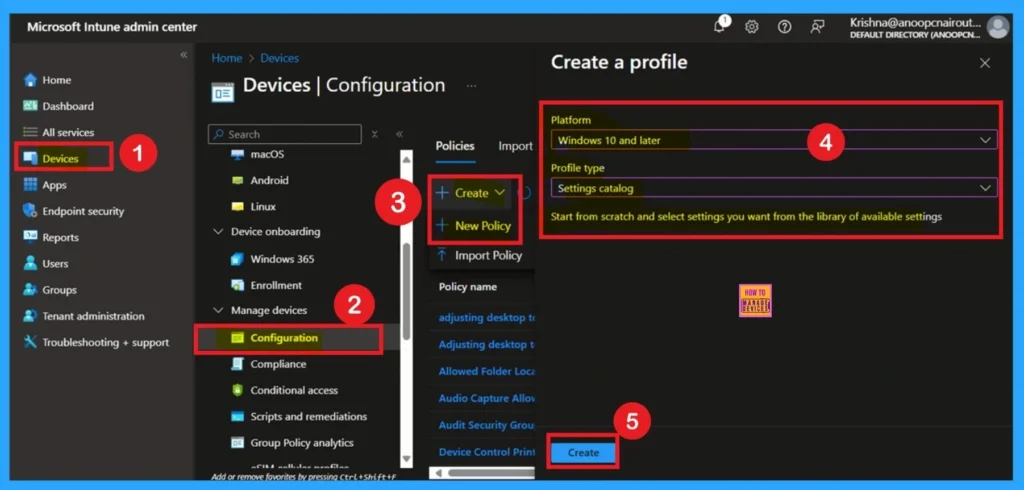
- How to Configure Microsoft Edge Favorites using Intune Configuration Profile Step-by-Step Guide
- Microsoft Edge Tabs Detailed Review
- Download Microsoft Edge ADMX Group Policy Templates
Organizations should enable this policy to improve both productivity and security. By preventing saved passwords from being deleted when Edge closes, employees can log in to business applications and websites more quickly without repeatedly entering their credentials.
When it’s disabled If the ClearBrowsingDataOnExit policy is also enabled at the organization level without the password exemption, passwords will be wiped when Edge exits.
What is a Basic Tab
What are Basics? The Basics section is the first step when creating a policy in Intune. In this step, you need to fill in the Name, Description, and Platform details for your policy. This helps in identifying and organizing the policy later.
- Here the Name as – Prevent passwords from being deleted.
- Description– Prevent passwords from being deleted if any Edge settings is enabled to delete browsing data when Microsoft Edge closes (User)

Configuration Policy
Once you finish the basic steps, you will arrive at the configuration settings page, where you need to click on the Add settings option. From there, go to the Microsoft Edge category and select Password Manager and Protection. Within this section, choose the setting Prevent passwords from being deleted.
Enabling this option makes sure that saved passwords are always saved , even if Microsoft Edge has been configured to automatically delete browsing data when the browser is closed.
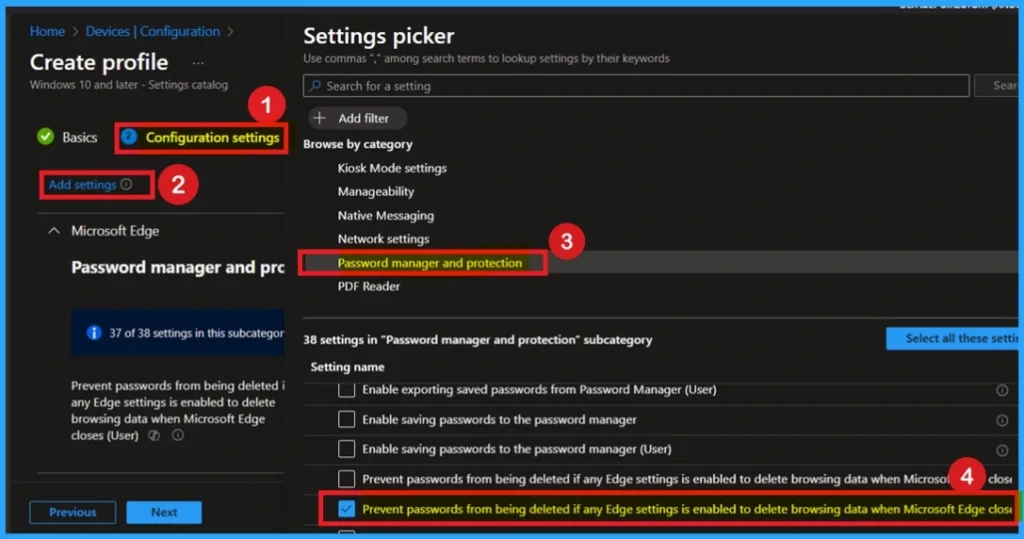
Defaulted Disable Mode
If you want to disable the policy, drag the toggle from right to left. In this mode, the toggle will turn gray, and the status will show as Disabled. This means the policy will not be applied to users. You can then click on Next to continue in the disabled mode.
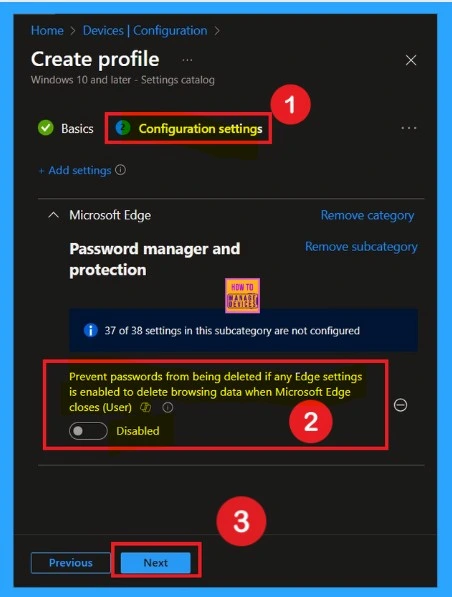
Enable the Policy
You can also enable a policy that is disabled by default. To do this, toggle the switch from left to right. Once enabled, the switch will turn blue and display the label Enabled.
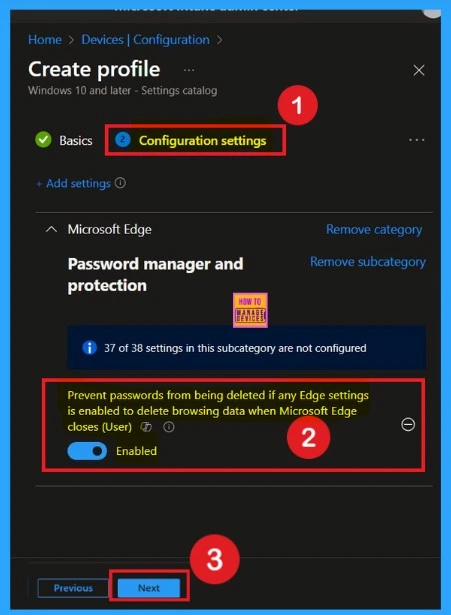
What is the Role of Scope Tags
Now you are on the Scope tags section. Scope tags are used to assign policies to specific admin groups for better management and filtering. If needed, you can add a scope tag here. However, for this policy, I chose to skip this section.
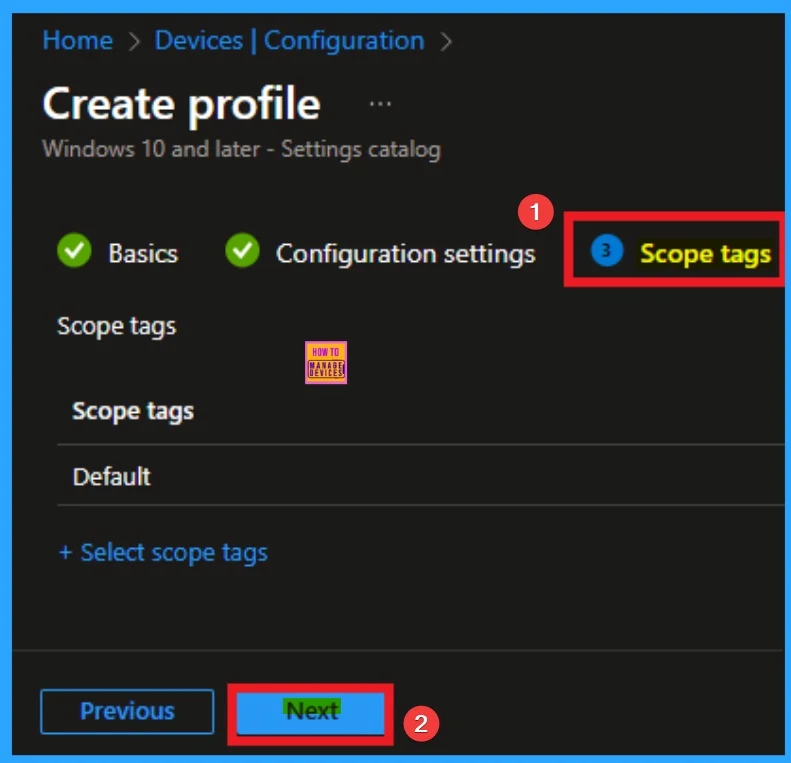
What is Assignments
To assign the policy to specific groups, you can use the Assignment Tab. Here I click, +Add groups option under Included groups. I choose a group from the list of groups and click on the Select button. Again, I click on the Select button to continue.
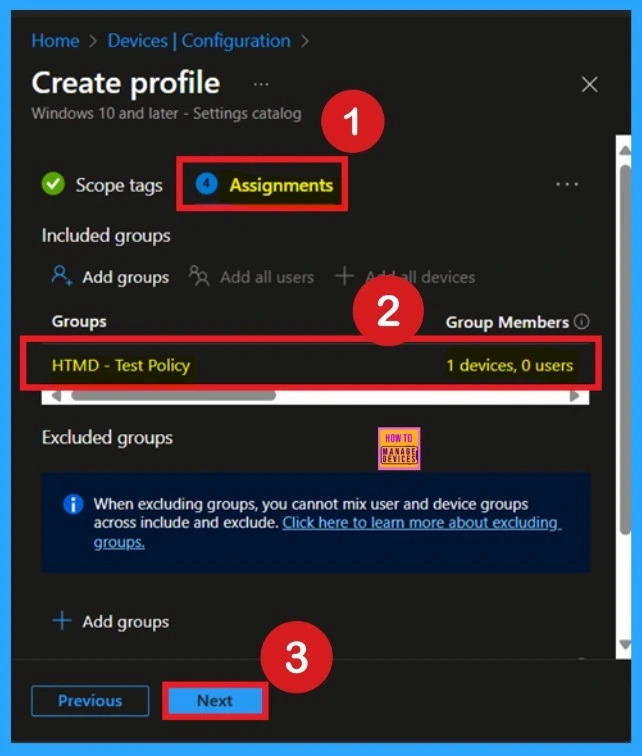
The Policy Now Created – Review + Create
Before completing the policy creation, you can review each tab to avoid misconfiguration or policy frailer. This tabs work as a summary page. After verifying all the details, click on the Create Button. After creating the policy, you will get a success message.
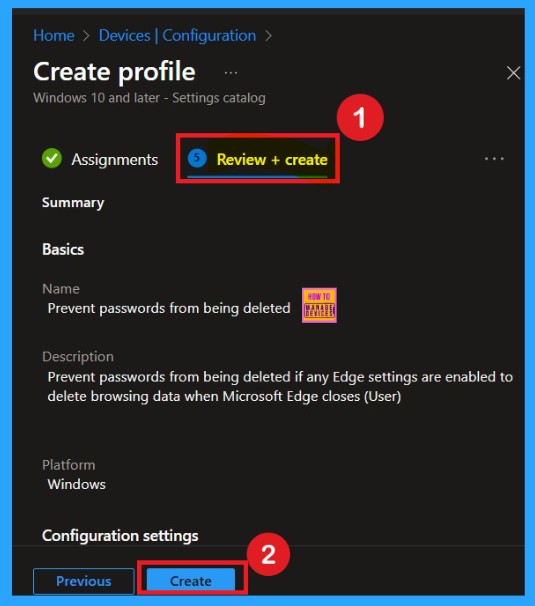
Monitoring Status
The Monitoring Status page shows if the policy is succeeded or not. o quickly configures the policy and take advantage of the policy sync the assigned device on Company Portal. Open the Intune Portal. Go to Devices > Configuration > Search for the Policy. Here, the policy shows as succeeded.
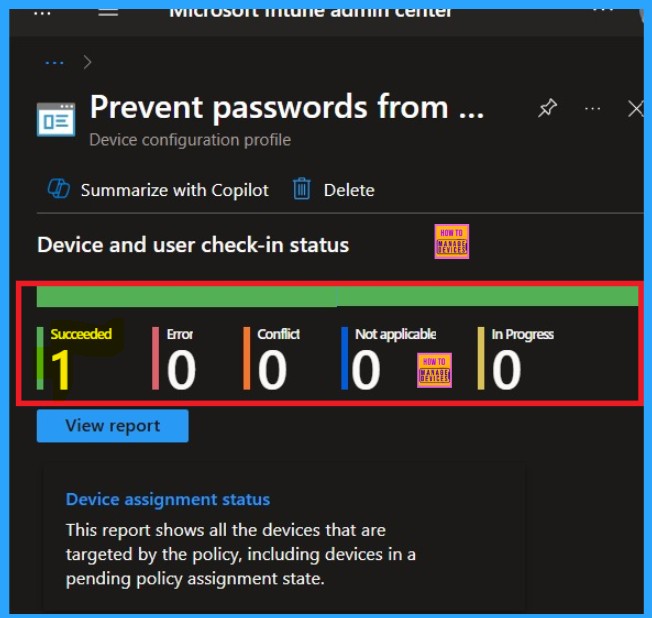
Client Side Verification
To get the client-side verification, open the Event Viewer and navigate to Applications and Services Logs > Microsoft > Windows> Device Management > Enterprise Diagnostic Provider > Admin. Once there, you can search for specific policy results by using the Filter Current Log feature located in the right pane. This helps quickly get the relevant results within the log.
| Info |
|---|
| MDM PolicyManager: Set policy string, Policy: (PasswordDeleteOnBrowserCloseEnabled), Area: (microsoft_edqev118~Policy~microsoft_edqe~PasswordManager), EnrollmentID requestinq merqe: (EB427D85-802F-46D9-A3E2-D5B414587F63), Current User. (S-1-12-1-3449773194-1083384580-749570698-1797466236), Strinq: (), Enrollment Type: (0x6), Scope: (0x1). |
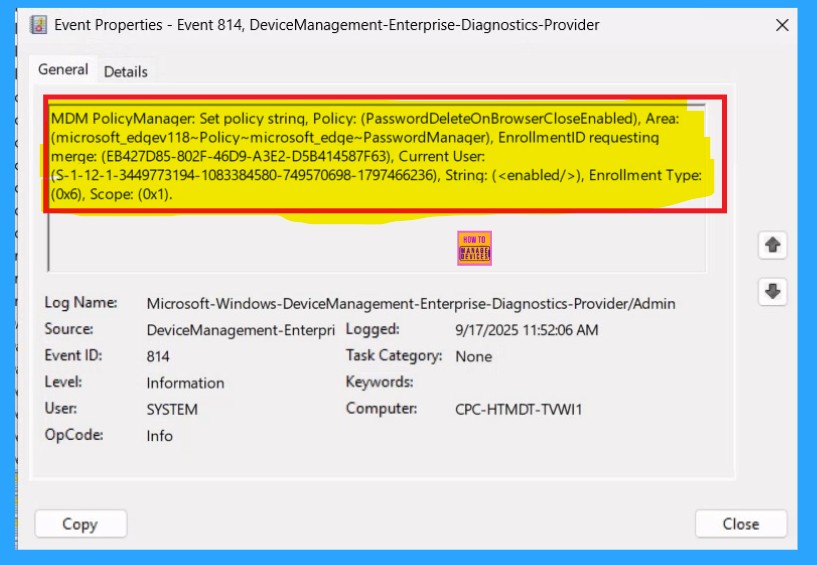
How to Remove Policy Group
If you want to remove the assignment group from the policy, you can easily do that for that. Start by navigating to the Monitoring status page via Devices > Configuration. Search for the policy by name and click on it to open its monitoring details. Scroll down to the Assignments section and click Edit. This will take you back to the policy’s assignment settings.
- From here, you can remove the group you no longer want the policy to apply to.
For detailed information, you can refer to our previous post – Learn How to Delete or Remove App Assignment from Intune using by Step-by-Step Guide.
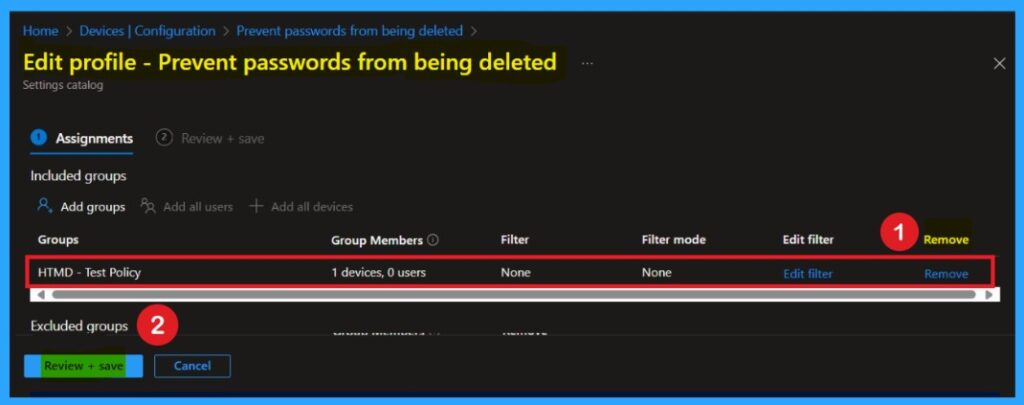
How to Delete the Policy that you created
To delete a policy in Microsoft Intune, first sign in to the Microsoft Intune Admin Center. Navigate to Devices and then select Configuration. Locate and select the specific policy you want to remove. Once you’re on the policy details page, click the 3 -dot menu in the top right corner and choose Delete from the available options.
For detailed information, you can refer to our previous post – How to Delete Allow Clipboard History Policy in Intune Step by Step Guide.
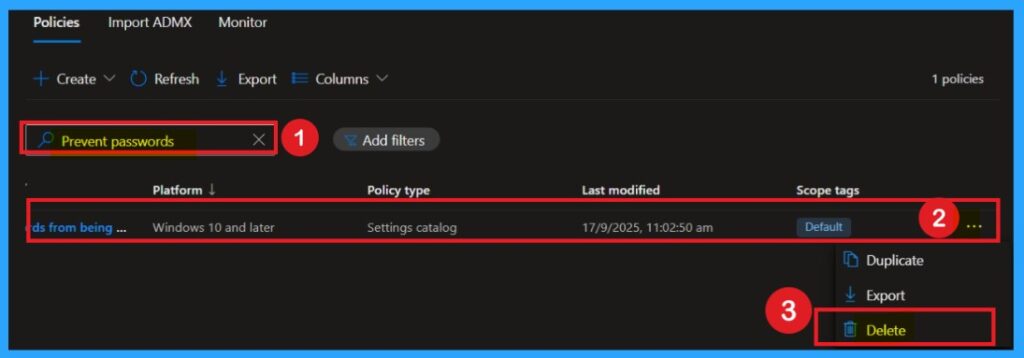
Need Further Assistance or Have Technical Questions?
Join the LinkedIn Page and Telegram group to get the latest step-by-step guides and news updates. Join our Meetup Page to participate in User group meetings. Also, Join the WhatsApp Community to get the latest news on Microsoft Technologies. We are there on Reddit as well.
Author
Anoop C Nair has been Microsoft MVP from 2015 onwards for 10 consecutive years! He is a Workplace Solution Architect with more than 22+ years of experience in Workplace technologies. He is also a Blogger, Speaker, and Local User Group Community leader. His primary focus is on Device Management technologies like SCCM and Intune. He writes about technologies like Intune, SCCM, Windows, Cloud PC, Windows, Entra, Microsoft Security, Career, etc.
